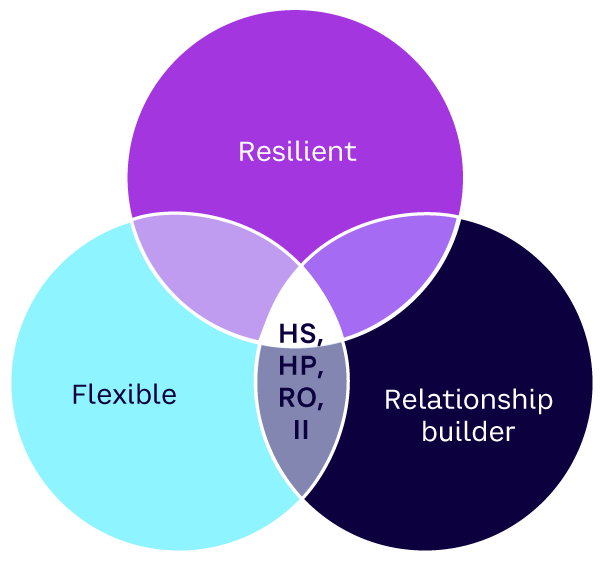AMPLIFY VOL. 36, NO. 2

Linda A. Patterson talks about the strength that women of color possess that “stems from endurance, perseverance, and survivorship.” Given their many roles in the workplace, home, and community, women of color excel at managing, creating, innovating, strategizing, and multitasking. These skills are often additive to their formal education and specializations. So why aren’t they being given an equitable seat at the table? Why do we still have low percentages of women of color in technology jobs, senior-level positions, and board roles? Patterson suggests five steps toward offering “equitable opportunities for women of color in a meaningful, sustainable, and measurable way.”
As a woman of color, it is important that when I consider employment with your organization, I see representations of myself in roles across the spectrum — including at the senior level. I’m not suggesting that job qualifications are irrelevant, of course, but I’m asking you to adjust your lens to look past gender and color for talent. Better still, look at women of color and recognize that your organization is in need of their talent.
Women of color are equipped with a tried-by-fire strength that stems from endurance, perseverance, and survivorship. Their formal education is greatly enhanced by the type of intelligence not found in books. Women of color know how to love with a strained, frayed heart and can face their fears without batting an eye.
As CEOs, mamas, and in every other role, women of color manage, create, innovate, strategize, and multitask. But even after adding these powers to their degrees and specializations, they remain a small piece of the diversity, equity, and inclusion (DEI) chart, especially in the upper echelons.
The Lean In organization found that for every 100 men promoted to manager, only 58 Black women are promoted, despite the fact that Black women ask for promotions at the same rate as men.1 This creates a deficiency in the number of Black women to promote at every level, increasing the representation gap.
Interestingly, women of color are projected to become the workforce majority by 2060.2 Not only that, but they come bearing gifts: US $1 trillion in their role as consumers and $361 billion as entrepreneurs.3 Talk about having a major impact on the marketplace. Clearly, companies without women of color are not going to succeed to the degree they would if they hired them. Indeed, these stats suggest businesses would be foolish to let their organization’s talent pool be tainted by a lack of equitable opportunities for women of color. Equity aside, businesses are looking to see that your products or services have been vetted by a diverse group of individuals.
Figure 1 shows the five steps businesses can take to create equitable opportunities for women of color in a meaningful, sustainable, measurable way.

1. Understand Her
Make a concerted effort to understand women of color. They want business leaders to appreciate and embrace their struggle. Get to know their well-designed minds and how their experiences impact the way they think, behave, and deliver. Know what is important to women of color (not just women in general) and get comfortable with the idea that they have unique variables at play.
For example, women of color are sometimes wary of acting assertively for fear they will be labeled as being too aggressive. In a similar vein, they may believe that asking too many questions will make them appear indecisive, and this can lead to them being less effective at their jobs.
Another important variable is an extremely low tolerance for inequitable work practices and harassment. This stems from centuries of racism and thus is deeply rooted; for women of color, physical and emotional abuse by other races is a societal norm. Reducing these types of issues requires policies that ensure neither discrimination nor harassment based on race, gender, or sexual orientation will be tolerated under any circumstances, including by top leadership (i.e., “no one is above the law”).
Training is the key to reducing harassment incidents, always keeping in mind that employees are often unaware of what could be considered harassment. At a previous employer, HR investigated a situation in which I saw inappropriate pictures on the computer screen of a peer (a white male). Although I did not feel sexually harassed, HR left no stone unturned. It investigated, acted, and brought the case to closure. Although HR certainly cared about me, the employee, it was also avoiding the potential for a lawsuit. Harassment in the workplace is just that serious.
Make sure a diverse group of individuals write, review, and approve your policies. Regularly review those policies to ensure they evolve with your changing workforce. Consider creating an internal dictionary highlighting words and phrases that may come across as offensive to others based on their culture. The latter falls under the category of respect: demonstrating appropriate etiquette is the way we place value on each other.
2. Educate Leadership
Leaders must be instructed by those at the very top to be intentionally inclusive and held accountable when they are not. They should be trained on the true meaning of DEI and exposed to the stories of women of color. Have them consider how a woman of color who had to constantly stretch a dollar to feed her family became a CFO. Note the ability of women of color to stand when others would collapse under the pressure of corporate America. Women of color are virtually unbreakable. As the poet Maya Angelou wrote, “You may shoot me with your words/You may cut me with your eyes/You may kill me with your hatefulness/But still, like air, I’ll rise.”
Look at corporate America’s constant barrage at women of color’s self-esteem and observe their ability to dodge those bullets and forge ahead. When women of color are rejected, they forgive and continue to extend courtesy to the people who rejected them.
Business leaders should be required to evaluate the impact women of color can have on the bottom line based on facts and what the market suggests. They should be encouraged to understand and respect the community that raised a woman of color and the place she received her education.
3. Create & Align Roles with Strengths
Women of color have three particular qualities that make them excellent employees and leaders. The first is resiliency. When people are constantly offered opportunities, they develop the habit of expecting things to happen with little to no effort on their part. When people must fight for every opportunity, they become highly resilient. (On a personal note, I experienced the latter: made to feel inferior, unworthy, the wrong gender, and certainly the wrong color at every turn. The idea was to hold me back, but that clearly backfired.)
The second quality is flexibility. Women of color learn to be highly flexible and creative in order to support and sustain their families. For years, they have similarly found ways to make their voices heard and be recognized in a world reluctant to do so. Against all odds, they nurture those who are unkind to them and those who refuse to see their achievements as noteworthy.
The final quality is a fierce passion for building relationships. Women of color are like thoroughbred horses with blinders on: single-mindedly finding creative ways to form amazing relationships. Women of color are kindhearted and able to read between the lines. They know how to cut to the chase and how to categorize relationships so they yield the right results. Women of color see into the souls of others and bring out the best in them.
Could you use someone who possesses these skills? Resilient workers see projects/initiatives through to the end. Flexible leaders view issues from various perspectives and find creative ways to resolve them. Compassionate leaders form solid relationships that yield exceptional results for the organization.
The intersection, and your ROI, is a high-spirited (HS), high-performing (HP), results-oriented (RO), intentionally inclusive (II) business (see Figure 2). There are people in your customers’ circle of business who look like women of color and share their experiences. Expand and grow your business with a brand that meets the diverse needs of your customer base. If you want to sell your new skin product to women of color, how will you do so without the marketing ability of someone who lives in that skin?

4. Measure Impact
Let business metrics, achieved or otherwise, tell the story. This creates an opportunity to exercise continuous quality improvement and celebrate successes. Your company’s gender and talent mix should be as equally proportioned as possible. Perfection is probably not achievable, but more balanced results will demonstrate excellence in achieving diversity goals.
This will take time and work. Being intentionally inclusive of women of color cannot be a fleeting thought; it must be an actionable item. Aim to have women of color in executive roles in about the same numbers of women of other races. Note that the message here is equality: having more women of color than other races/ethnicities in key roles is also not the answer.
Measuring your results is incredibly important. This is not complicated math. Measure the number of individuals joining your organization and note into which race category they fall. Be granular in your approach, comparing the education, experiences, and talents of each candidate. (This is a good place to say that your HR team must be well trained and intentionally diverse in their staff acquisition, employee retention, and talent management.) The numbers may look bleak at first, but that should help drive the type of II initiatives you create.
Develop goals that begin at the top and cascade down to your lowest staff level. Everyone’s goals should be in alignment from the top, and the talent needed to fulfill them should be clearly identified. This includes women of color. When you observe the goals and their alignment with that of the organization, eliminate biases. An assumed bias or generalization is an opportunity for improvement and growth.
Identify educational gaps and extend the mentoring, training, and resources needed to excel. Note where each woman of color started, her end results, and her motivators. Like everyone, the woman of color needs direct, concise feedback and celebration of her successes, large and small. For example, if the goal is to increase market share by 10%, track how the woman of color contributes to this goal. In other words, find where she thrives and utilize her in that capacity.
Establishing clear metrics, and measuring accordingly, will highlight even more of what women of color bring to your company, its relationships, and its bottom line. Allow your customers transparency into your DEI efforts and the impact of women of color.
Make sure to measure the “I can see myself” factor. When individuals in your organization see people like them in certain roles, their goals feel more achievable. When those seeking to join your organization can picture themselves there, it’s easier to attract diverse top talent.
Measure how you are marketing for and attracting women of color. Build partnerships with organizations and associations that support women of color such as the National Black MBA Association (NBMBAA) and the Information Technology Senior Management Forum (ITSMF).
Ask women of color their thoughts, engage them in challenging decision-making, and assign them high-visibility projects. Uncast the shadow and let them demonstrate their value. If one woman of color does not work out, don’t let them become a premise for avoiding such hires. You have every right to dismiss inferior performance; just make sure your practices are consistent across the board. Give the woman of color the same opportunities to succeed that you would her female or male counterpart of a different race.
5. Prioritize
Does this sound like tedious work? It is, but it’s achievable. Make time for it or leverage your staff. Consider hiring an intern or some temporary staff to do some of the work. Leverage the time and talent of your employee resource group (ERG) members. Don’t have an ERG? Add this to the top of your DEI initiatives list! Don’t have such a list? You’re behind the eight ball and need to catch up — fast.
Women of color belong in your business. If you’re not creating equitable roles for them, you’re dismissing their immense value and may struggle to remain competitive as other businesses embrace their power.
References
1 “The State of Black Women in Corporate America 2020.” Lean In, accessed February 2023.
2 Pace, Cindy. “How Women of Color Get to Senior Management.” Harvard Business Review, 31 August 2018.
3 Pace (see 2).



